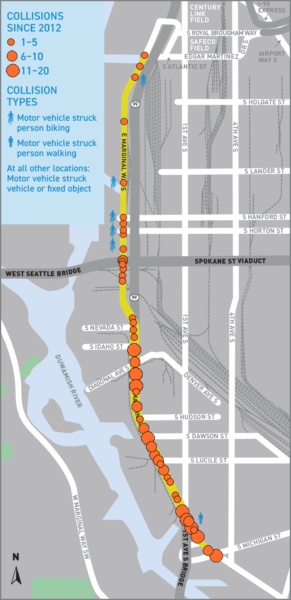 Today is the last day to comment on SDOT’s E Marginal Way online open house.
Today is the last day to comment on SDOT’s E Marginal Way online open house.
The city is working on a major reconstruction and redesign of the industrial street that also serves as one of the most vital bike connections for West Seattle, the Duwamish Valley and beyond.
As a regional bike route, the street must include a complete, safe and intuitive facility. At the same time, this street is somewhat unusual in that it has low personal car traffic (though that could change when the downtown tunnel highway opens). Instead, the mix is mostly people walking and biking and people driving very large trucks to access the Port of Seattle driveways. It’s a street that almost only has the extremes in vehicle sizes, and that may actually be an opportunity instead of a problem.
E Marginal Way is the city’s best chance to showcase how comfortable, predictable and separated biking and walking routes are good for freight.
It’s obvious that the modes cannot mix, and on that point essentially everyone agrees. This need is highlighted by the tragic May 2013 death of Lance David at E Marginal and S Hanford. David was the father of twins who lived in Federal Way and biked to work in downtown Seattle.
So we know people biking and walking need to be separated from heavy trucks, and we know those connections need to be complete and intuitive. What’s the best way to do that?
The online open house includes three options for the north segment between Atlantic (where the Alaskan Way Trail ends) and Spokane (where the Alki Trail to West Seattle ends). It also includes some ideas for the southern segment between Spokane and the 1st Ave Bridge, which we will discuss later in this post.
Option 1 – Enhanced Existing

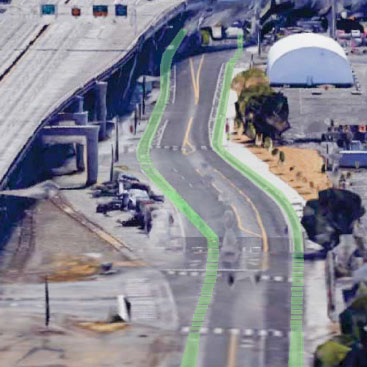
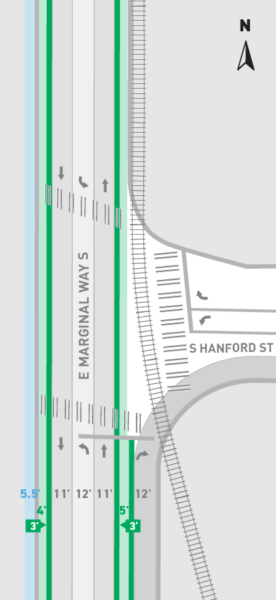 This option is basically what currently exists, but with wider buffers between the paint-only bike lanes and the general traffic lanes.
This option is basically what currently exists, but with wider buffers between the paint-only bike lanes and the general traffic lanes.
The bike lane and right turning traffic lane still cross each other at S Hanford, which is not the level of separation this project should be aiming for.
This option also doesn’t fix the lack of a quality connection at Spokane, an area where today people biking northbound choose many different methods for getting to the northbound bike lane, some crossing at the signal at Spokane and others biking down the west sidewalk for a bit before picking a spot to cross.
When you have a lot of users making many different route decisions in the same area, that’s a clear sign that the street design does not have an obvious and intuitive option that is direct and safe. The status quo fails by this measure, so the new design needs to do better. Option 1 doesn’t cut it.
Option 2 – Two-way bikeway on the east side of the street


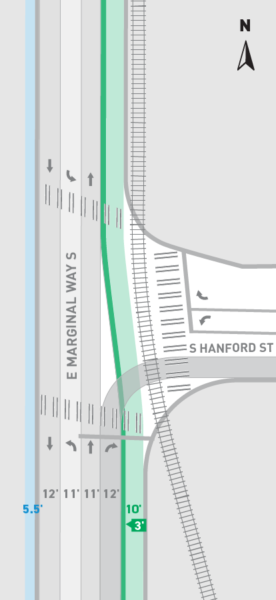 This option would essentially shift people biking to the east side of the street while keeping the sidewalk on the west side. A two-way bikeway on the east side could be a strong option because it will avoid all Port driveway crossings, and it should include fully separated phases at the few intersections it crosses.
This option would essentially shift people biking to the east side of the street while keeping the sidewalk on the west side. A two-way bikeway on the east side could be a strong option because it will avoid all Port driveway crossings, and it should include fully separated phases at the few intersections it crosses.
This option could be more intuitive at both the Spokane and Atlantic connections if the designs of those intersections are done well, but that’s a big “if.” Requiring a significant wait at the crossing at Spokane might result in people continuing to find a shorter route by using the west sidewalk, which is the problem we have today.
The connection at Atlantic is vital and could be tricky. A lot of northbound truck traffic will be trying to turn across the bikeway, which would be between the train tracks and truck traffic. There is a way to make this work well with significant barriers and separated signal cycles, but the city can’t cut corners on the intersection designs. If it isn’t easy and safe, people will invent their own routes.
So I say we put an asterisk on this option. It will only work with strong design and bike-friendly signal timing. But designed well, it could be a fantastic solution.
Option 3 – ‘Wide,’ multi-use trail on the west side

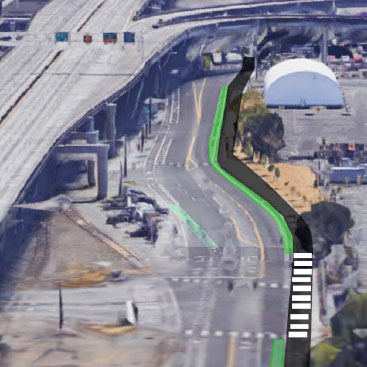
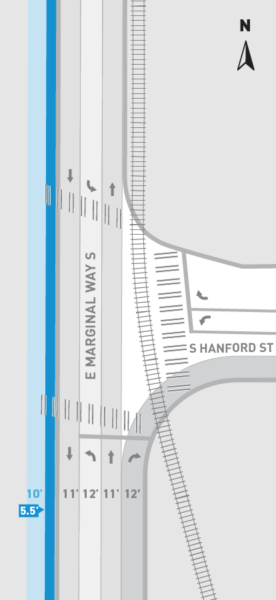 This option would essentially connect the Alaskan Way Trail and the Alki Trail into one long trail (and when the waterfront rebuild is complete, this trail would also connect to the Elliott Bay Trail, which could soon connect to the Ship Canal Trail, which connects to the Westlake Bikeway and the Fremont Bridge and the Burke-Gilman Trail and wow this network thing could finally be coming together).
This option would essentially connect the Alaskan Way Trail and the Alki Trail into one long trail (and when the waterfront rebuild is complete, this trail would also connect to the Elliott Bay Trail, which could soon connect to the Ship Canal Trail, which connects to the Westlake Bikeway and the Fremont Bridge and the Burke-Gilman Trail and wow this network thing could finally be coming together).
The trail option is definitely the most intuitive at both Atlantic and Spokane. It also avoids crossing intersections and would have the fewest traffic signals, so it would probably be the fastest route for people biking.
However, this option would cross every Port driveway. Many hours, this is not a big deal since the driveways are closed or have very little activity. But when they are busy, they are busy.
Basically, of the options presented, this is the one to beat.
A hybrid ‘Option 4’?
There may be space for a hybrid option that is both intuitive at the Spokane intersection and avoids the Port driveways on the west side of the street. Don Brubeck from West Seattle Bike Connections and a member of the Seattle Bicycle Advisory Board put it this way in his comment letter:
A hybrid option of multi-use path on west side from S Spokane to S Hanford, making S Hanford an efficient protected intersection with bike and vehicle sensors, and then two-way protected bike lane on east side to S Atlantic St. with concrete barriers. It would give the Port terminals more safety, efficiency and location flexibility for their gates, and avoid the most intersection and driveway crossings.
This option is highly reliant on good design and responsive signal times, but it could be a great solution for all parties if done right. Again, that’s a big “if.”
It solves the initial problem of connecting to the Alki Trail at Spokane by creating a no-wait turn along the west side of the street all the way to Hanford. This stretch avoids any conflicts under the Spokane Street Viaduct and doesn’t cross any driveways. For people biking, this is the fastest and most direct route.
Hanford is the trickiest part. It’s the first driveway and an intersection with many turning trucks. The city would need to find a way to get two-way bike traffic from the southwest corner of the intersection to the northeast corner in a safe, predictable and comfortable way. This is possible, but the whole option falls apart if the design of this intersection is not superb.
This option would also need to address the intersection at Atlantic as discussed above in Option 2. I think there’s a good way to do it, but it must be done well or, again, the whole option falls apart.
South Segment to Georgetown
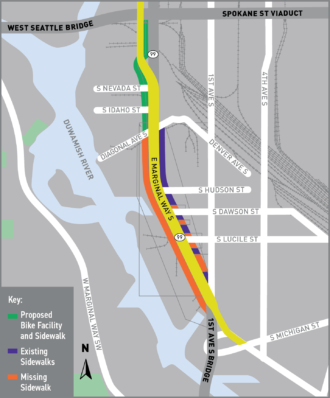 The E Marginal project is also looking to make some changes to the much busier segment south of the Spokane Street Viaduct and through Georgetown.
The E Marginal project is also looking to make some changes to the much busier segment south of the Spokane Street Viaduct and through Georgetown.
At a minimum, the city wants to build a trail connection from the Alki Trail to Diagonal Ave S, which would get people walking and biking through a tricky and confusing stretch of freeway ramps and semi truck parking. This is great news.
But we can do better. This project should include a connection all the way to the 1st Ave Bridge, which already has a quality biking and walking facility and connects to the southern section of the Duwamish Trail into the heart of South Park. The Seattle Bicycle Master Plan calls for a multi-use trail on E Marginal between these bridges, and that’s exactly what we should be trying to build in this project.

A complete connection to the Alki Trail and the remade E Marginal bike route would create a significant shortcut to downtown Seattle for people in Georgetown, South Park and south King County. It would bring Seattle’s separated bike network tantalizingly close to the Green River Trail (and, therefore, the Interurban Trail) just south of South Park and the Seattle city limits. Such a connection would activate big sections of south King County. It would provide many more communities with safe biking and walking access to Seattle, including Allentown and other parts of Tukwila, Southcenter, Kent and Auburn.
Unfortunately, a complete biking and walking connection between Spokane and the 1st ave Bridge is not being considered currently. And as a state highway, making changes to this stretch requires more collaboration and more bureaucracy.
But a safe connection could have an immense regional impact and would serve many communities without easy and safe access to healthy transportation options like walking and biking today.
This is a great opportunity for a regional leader to step up and push for a complete link to Georgetown, South Park and the Green River Trail. We are so close, let’s just complete the connection now all at once. It’s the right thing to do, and it would provide a healthy transportation option for growing communities that are otherwise dependent on buses and driving on increasingly congested roads and highways.

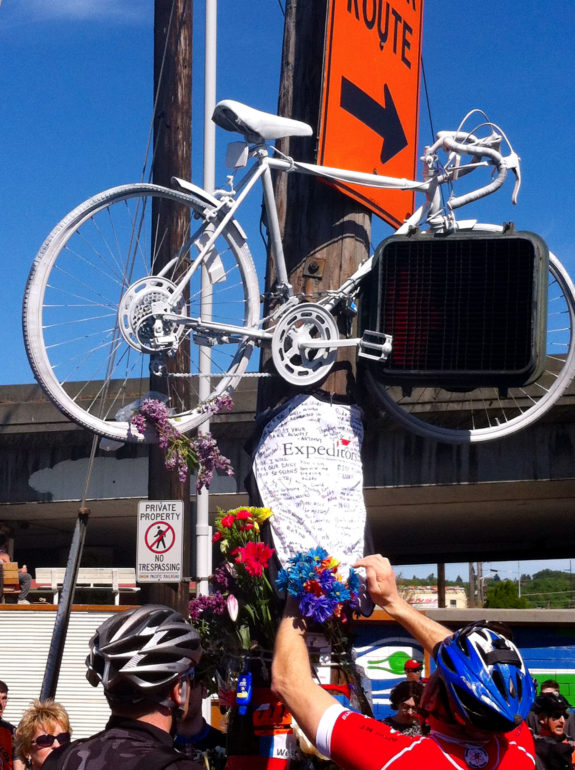







Comments
25 responses to “Options for a redesigned E Marginal Way + Regional leadership needed to connect to S King County”
This is my daily commute. It’s not always fun. I saw Lance David being covered with a sheet in the street. We must improve this route.
I agree that a west-sided route is most intuitive, though it’s also very bumpy. I think most people ride the sidewalk until they think it’s safe to cross to the bike lane, which is smoother.
My biggest fear currently is accessing the lovely separated trail on the First Avenue Bridge from Georgetown to South Park. It’s basically riding in the fast lane on the highway to get there. To the extent that drivers look up from their phones and notice me, they seem a bit surprised. Then, when it’s dark and people living under the bridge have loose dogs that charge at bikes, it makes for a pretty scary situation, and one I haven’t figured out how to avoid it. It’s not just poorly marked, it’s super dangerous.
Take a look: https://www.google.com/maps/@47.5450265,-122.3310924,3a,75y,242.8h,71.22t/data=!3m6!1e1!3m4!1sjFx7I-QWi9_wK3B-Z5-RpA!2e0!7i13312!8i6656!6m1!1e1
I’ve done the commute up from Tacoma 3 times. The closest call I’ve had cycling was on E. Marginal….car doing at least 50 missed me by less than a foot. I’m glad this is getting the attention it deserves.
I commute over this. Depends on the time of day and the day. When the trucks are lined up waiting to enter the terminal, cars pass and often don’t see bikers. I ride the sidewalk when this happens. When there are no trucks, the cars drive really fast. The roadway is not smooth, there are a lot of pot holes and some tracks. the debris on the road can get really bad.
I must confess, a separate multiuse path seems best to me as the truck tires won’t chew it up. To be away from the trucks and cars seems safest. I think some speed bumps on the road to slow the drivers down would also be very very good. A street sweeper to get rid of the flat-inducing bits would be so nice.
I also road this on the day David Lance was killed. I passed by about an hour before but saw the aftermath later that day. Sad.
Sometimes if I check the traffic cams, I can see the lineup for the terminal with the trucks. If i leave late enough, I just take the water taxi to avoid this area. If I have to get in early, I stay on the sidewalk.
don
I ride this corridor frequently as well and I’m glad to hear they’re looking into improving it.
I think I like option 3 the most as it seems simplest to implement. The current west side configuration seems like it wastes a lot of space on a separate sidewalk that gets very infrequent use. I think I see people riding their bikes northbound on the sidewalk more often than I see an actual pedestrian use it. Combining all of that space into a single multi-use path would make much more sense. Though I have to admit that I must consistently get lucky in that I’ve never ridden though this area while heavy trucking traffic was present. Maybe that biases my opinion a bit.
For any of options 1, 2, or 4 to work very well they would definitely have to improve the traffic signaling. All of the lights in the area seem to have a very trucking oriented setup in that they will alternate directions based on a very long timer (even when little to no car/truck traffic is present). These signals would need to be much more responsive to bicyclists. As it is just about every biker (northbound or southbound) seems to run a red at Hanford street in low traffic situations.
I would also happily support a better route from the 1st Ave Bridge to Spokane street. If such a route existed then I could cut a mile off my route and skip the Alki trail altogether.
With the traffic signals the way they are today, cyclists run them or avoid them, and it’s hard to blame ’em. We’re routinely delayed at signals (especially Atlantic) whether there’s any other traffic around or not. If we change all the signals to have bike-specific phases, it’s a near guarantee the delays will get worse. Unlike 2nd Ave, where there’s lots of traffic around and people mostly follow the law, on Marginal there’s practically no traffic. That means more cyclists running lights at intersections just weird enough to be dangerous, and more cyclists trying to cut across car, truck, and bike lanes in odd places to avoid waiting at signals.
This isn’t exactly today’s orthodoxy, but I think the Hanford intersection might be better if it went “flashing red” (all-way stop) whenever traffic was light. Maybe Atlantic, too.
Right: you wait 10 minutes for the light to change and then a truck slowly rolls into the intersection and gridlocked it for you. It happens every time. You can’t blame cyclists and pedestrians for not waiting.
This is my commute too. @admiraldon is so right about the need for a street sweeper. I pop 10+ tubes a year long this section. I like the west-side trail option, anything that requires crossing East Marginal will be a wasted opportunity because cyclists will still cross wherever there is an opening between semi trucks rather than at Hanford or Spokane. I think the connection at Atlantic is not a big issue, hardly any cars or semis try to go east when they can just take Colorado over the top of 99.
With regards to Hanford, there is almost no chance of vehicles crossing westbound into the SSA Marine parking lot, I don’t know why there is an east-facing light at all at that intersection, so a west side trail would eliminate many truck/bike conflicts. There are a couple more driveways before you get to Atlantic but used so rarely that signage should be able to alleviate potential traffic conflicts.
At Hanford, the timing of the light in the past year or so has been much improved in that there’s never an eastbound light and the left turn from S-bound Alaskan only activates if there’s traffic waiting in that lane. Contrary to the situation prior to modernizing the timing, there’s always a green light coming in less than a minute. The only quibble might be that the north-south light will go red even without any traffic waiting on Hanford.
The objections of option 3 crossing port driveways are a little odd. There is only one entry in use, and other others share a light/road crossing so they will effect the east alignment.
Everything in south of Spokane is a total sh*t show. The port has wasted millions of dollars, and SDOT rubber stamped all the fright specific infrastructure that makes the area hostile to all forms of travel but freight.
If folks want to get involved with biking and walking advocacy in Georgetown and South Park, please join the Duwamish Valley Safe Streets group (the local affiliate of Seattle Neighborhood Greenways). They are an inspiring group of people and this is one thing they have been advocating on.
Way to get connected to Duwamish Valley Safe Streets:
Email: https://groups.google.com/d/forum/duwamish-valley-safe-streets
Twitter: https://twitter.com/dvsafestreets
Facebook: https://www.facebook.com/DVSafeStreets/
Riding a bike thru this most air polluted area of Seattle on a frequent basis won’t be good for your health. What’s the alternative though. Mass transit through it?
Sorry bub, but the studies have shown that the health benefits from biking, even in more polluted areas, outweighs the negatives from pollution.
Oh really.
http://invw.org/2011/06/13/breathing-uneasy-air-pollution-crisis-in-south-seattle/
Ya rly: https://www.theguardian.com/environment/2016/may/05/benefits-cycling-walking-outweigh-air-pollution-risk-cities
This study even says they are not saying that air pollution isn’t detrimental. You can have other activities to reduce obesity other than exercising in documented polluted air. People may have varying tolerances to air pollution. Children are more susceptible to pollutants in the Duwamish Valley.
People living in the area are exposed to pollution all day and night, whether they’re riding or not. Whatever they do to stay active they’re likely doing it under the same cloud of pollution. A bike path that lets them ride out to somewhere cleaner? Probably a good thing. For people living in places like Georgetown and South Park, a bike trail on East Marginal would help people get to Alki Beach, the Green River Trail, and a few other fun outdoor destinations. Back when Metro route 48 was introduced (way before I was in Seattle; I read an article on it), advocates for the route didn’t just bring up access to UW, but also Green Lake. It’s like that.
Additionally, bike access to a job really can make a difference for families: the ability to get by with one fewer car, which can save a lot of money! When I was home from college one summer and my brothers and I all had summer jobs, the lack of safe bike access made for a lot of obligatory car commutes, and we ended up buying an extra car — a large expense and hassle for such a short-term need! One good route from an existing bike path into an industrial job center would have spared us this. For this purpose, 1st Ave S probably provides direct access to more jobs and destinations than 99, but a route along 99 plus some good crossings of 99 could do the trick.
Before this conversation gets derailed, do note that I was responding to his original comment: “Riding a bike thru this most air polluted area of Seattle on a frequent basis won’t be good for your health.”
This to me seems a comment on people biking from not-so-polluted areas, through a polluted area, to their place of work, which the link I posted claims is still a health positive activity.
Obviously living in a polluted area, breathing in polluted air 24/7, is detrimental to your health. That’s been clear since the Industrial Age kicked off.
Sure would have been nice if you had published this when the open house started, not on the last day to make public comment. I have been waiting for this for years, and this is the first I have seen any outreach.
I too will never forget riding right past Lance David covered by a white tarp on that sunny bike-to-work morning. It’s just not something you can ever forget.
Option 3 needs to happen. The vast majority of biking and walking trips are heading to and from West Seattle at this location. There is no alternative. A really well done separated trail on the west side solves all problems. Get it done.
Yeah, I apologize for getting this out so late. For some reason, I thought I had more time. Don Brubeck gets credit for reminding me of the deadline.
I definitely prefer the completely separated bike facility on the west side of the street. This is the only option that I would feel comfortable taking my kids on. I would love to have a safe option to ride into the city with my kids! Anything on the east side of the street is going to have people crossing in unsafe locations.
Also, a separated bikeway on the west side is more likely to stay clean of debris.
This is a major connection to West Seattle and I so often talk to people who try bike commuting and mention how uncomfortable they are on East Marginal. It would be amazing to make this a safe comfortable connection for everyone.
South of Spokane (W Sea Bridge), a bike lane on 99 is a mediocre idea. 1st Ave would be better.
Over that stretch, 99 is essentially a freeway w rail crossing and and multiple on-off ramps.
Conversely, 1st is broad enough for bike Lanes, relatively low traffic, has an existing bike lane (er, wide widewalk) over the existing bridge that crosses the rail yard.
And 1st could better serve Georgetown on the way down to S King.
I agree with a 1st Ave alignment south of Spokane. The trick would be a logical and safe way to get between the marginal section north of Spokane and a 1st Ave S section south of there.
Yeah – connecting bike infrastructure to 1st south of Spokane:
Couple things. There is already a bike lane on Marginal Way to Spokane Street. There will soon* (SDOT Time) be an extension of the SODO Bike Trail all the way to Spokane – at 6th St.
It’s not crazy to expect people to be able to get from either 6th or Marginal Way to 1st Ave, right?
Ultimately, the SODO Trail should terminate in Georgetown… but dream on, right? I’m content w/ trying to get minimally acceptable routes out of SDOT, to at least connect the major ‘hoods – Gtown, SPark – to downtown.
New evidence shows walking in polluted air does not outweigh benefits of the exercise.
https://www.huffingtonpost.com/entry/air-pollution-cities-cars-exercise-over-60s_us_5a26ffabe4b08220bd78872f